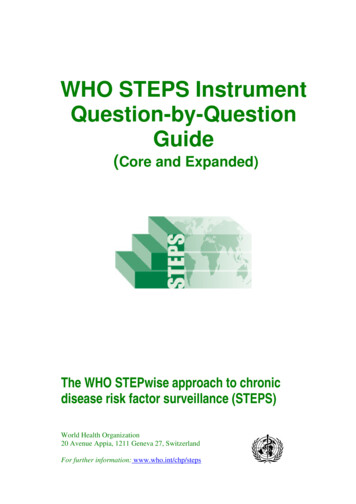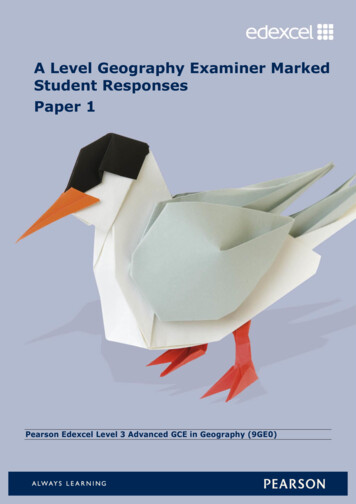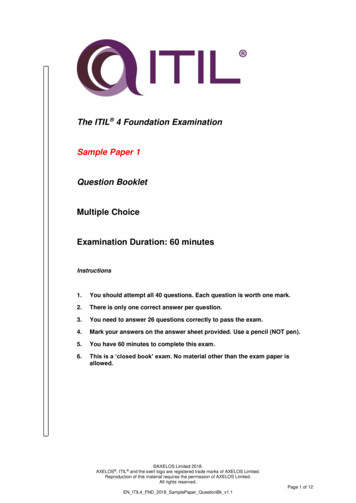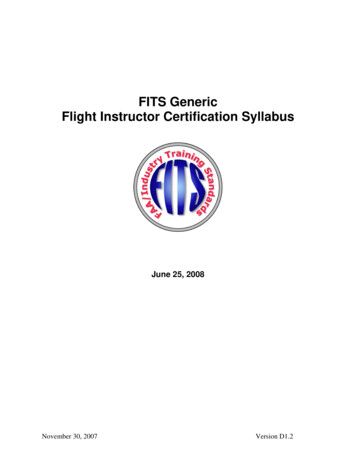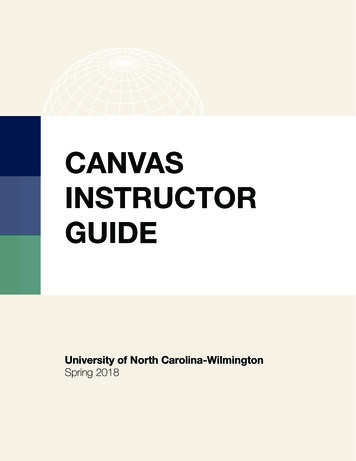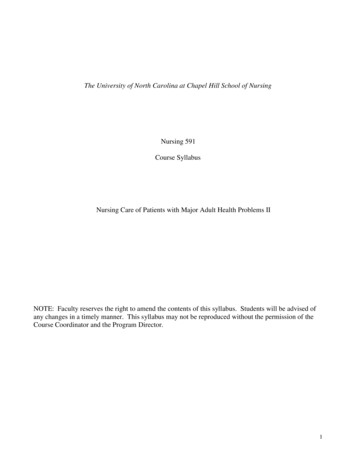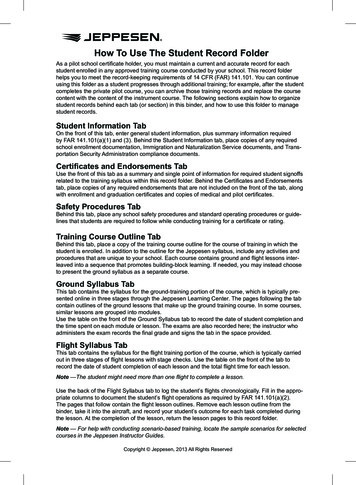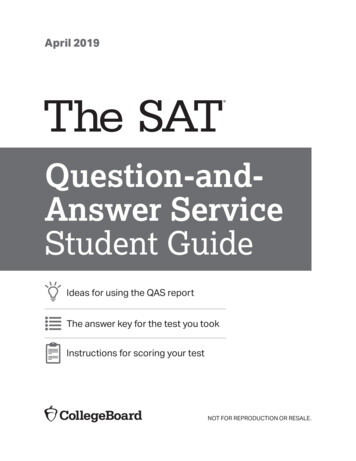
Transcription
University of MumbaiRevised Syllabus andQuestion Paper Pattern ofCourses of B.Com. ProgrammeatS.Y.B.Com.Semester III and IV Accountancy and Financial Management Paper-III Accountancy and Financial Management Paper-IVUnder Credit, Grading and Semester SystemWith Effect from Academic Year 2013-2014Board of Studies-in-Accountancy, University of Mumbai1
Revised Syllabus and Question Paper Pattern of Courses ofB.Com. Programme at S.Y.B.Com. Semester IIIwith Effect from the Academic Year 2013-2014Semester IIIAccountancy and Financial Management Paper-IIIModules at a GlanceSr.No.ModulesNo. ofLectures1Partnership Final Accounts based on Adjustment of Admissionor Retirement / Death of a Partner during the Year182Piecemeal Distribution of Cash143Amalgamation of Firms144Accounting with the Use of Accounting Software14Total602
Sr. No.Modules / Units1Partnership Final Accounts based on Adjustment of Admission or Retirement/ Death of a Partner during the YearSimple final accounts questions to demonstrate the effect on finalAccounts when a partner is admitted during the year or when partnerRetires / dies during the yearAllocation of gross profit prior to and after admission / retirement / death whenstock on the date of admission / retirement is not given and apportionment of otherexpenses based on time / Sales/other given basisAscertainment of gross profit prior to and after admission/retirement / death whenstock on the date of admission / retirement is given and apportionment of otherexpenses based on time / Sales / other given basisExcluding Questions where admission / retirement / death takes place in the sameyearPiecemeal Distribution of CashExcess Capital Method onlyAsset taken over by a partnerTreatment of past profits or past losses in the Balance sheetContingent liabilities / Realization expenses/amount kept aside for expenses andadjustment of actualTreatment of secured liabilitiesTreatment of preferential liabilities like Govt. dues / labour dues etcExcluding: Insolvency of partner and Maximum Loss MethodAmalgamation of FirmsRealization method onlyCalculation of purchase considerationJournal/ledger accounts of old firmsPreparing Balance sheet of new firmAdjustment of goodwill in the new firmRealignment of capitals in the new firm by current accounts / cash or acombination thereofExcludingCommon transactions between the amalgamating firmsAccounting with the Use of Accounting Software*Cost Centre, Cost Categories*Inventory- Creation of groups, Creation of stocks, Stock Categories* Inventory vouchers-Stock Journal, Manufacturing Journal, GodownManagement, Batch wise Management2343
Question Paper PatternMaximum Marks: 60Questions to be Set: 04Duration: 2 Hrs.All Questions are Compulsory Carrying 15 Marks each.Q-1Q-1Q-2Q-2Q-3Q-3Q-4Q-4Full Length Practical QuestionORFull Length Practical Question15 MarksFull Length Practical QuestionORFull Length Practical Question15 MarksFull Length Practical QuestionORFull Length Practical Question15 MarksObjective Questions*(*Multiple choice / True or False / Match the columns / fill in the blanks)ORTheory questions*(*Short notes / short questions)15 Marks15 Marks15 Marks15 Marks15 MarksNote: Full length question of 15 marks may be divided into two sub questions of08 and 07 marks.4
Revised Syllabus and Question Paper Pattern of Courses ofB.Com. Programme at S.Y.B.Com. Semester IVwith Effect from the Academic Year 2013-2014Semester IVAccountancy and Financial Management Paper-IVModules at a GlanceSr.No.ModulesNo. ofLectures1Fire Insurance Claims152Redemption of Preference Shares153Redemption of Debentures154Accounting with the Use of Accounting Software15Total605
Sr. No.Modules / Units1Fire Insurance ClaimsComputation of loss of stock by fireAscertainment of claim as per the insurance policyExcluding loss of profit and consequential loss2Redemption of Preference SharesCompany Law / Legal Provisions for redemption of preference shares inCompanies ActSources of redemption including divisible profits and proceeds of fresh issue ofsharesPremium on redemption from security premium and profits of companyCapital Redemption Reserve Account - creation and use3Redemption of DebenturesRedemption of debentures by payment from sources including out of capital and /or out of profits.Debenture redemption reserve and debenture redemption sinking fund excludinginsurance policy.Redemption of debentures by conversion into new class of shares or debentureswith options- including at par, premium and discount.4Accounting with the Use of Accounting SoftwareAdvance accounting and Inventory Vouchers: Purchase and Sales Order,Reorder, Delivery Notes,Budgeting and Controls,Invoice-Product Invoice and Service InvoiceShortcut Keys: Special key Combination, Special Functional key CombinationManagement Information System (MIS)6
Question Paper PatternMaximum Marks: 60Questions to be Set: 04Duration: 2 Hrs.All Questions are Compulsory Carrying 15 Marks each.Q-1Q-1Q-2Q-2Q-3Q-3Q-4Q-4Full Length Practical QuestionORFull Length Practical Question15 MarksFull Length Practical QuestionORFull Length Practical Question15 MarksFull Length Practical QuestionORFull Length Practical Question15 MarksObjective Questions*(*Multiple choice / True or False / Match the columns / fill in the blanks)ORTheory questions*(*Short notes / short questions)15 Marks15 Marks15 Marks15 Marks15 MarksNote: Full length question of 15 marks may be divided into two sub questions of08 and 07 marks.7
Reference BooksSr.Title of theAuthor/sPublisherNo.Reference Book1Introduction to AccountancyT.S. GrewalS. Chand and Co. (P) Ltd., New Delhi2Advanced AccountsShukla and GrewalS. Chand and Co. (P) Ltd., New Delhi3Advanced accountancyR.L. Gupta andS. Chand and Co. (P) Ltd., New DelhiM. Radhaswamy4Modern AccountancyMukerjee and HanifTata Mc. Grow Hill and Co. Ltd.,Mumbai5Financial AccountancyLesile ChandWichkPretice Hall of India Adin Bakley (P)Ltd.6Financial Accounting forManagement Texts andCasesDr. Dinesh D. HarsalekarMulti-Tech. Publishing Co. Ltd.,Mumbai7Financial AccountingP.C.TulsianTata Mc. Grow Hill and Co. Ltd.,Mumbai8Accounting PrinciplesR.N. Anthony and J.S.ReeceRichard Irwin Inc.9Financial AccountingJ.R. Monga, Girish Ahuja Mayur Paper Backand Ashok Shehgal10Advanced AccountsM.C. Shukla, T.S.Grewaland Gupta11Compendium of Statementand Standard Of Accounting12Indian Accounting StandardAshish BhattacharyaTata Mc. Grow Hill and Co. Ltd.,Mumbai13Financial AccountingWilliamsTata Mc. Grow Hill and Co. Ltd.,Mumbai14Indian Accounting Standardsand US GAAPDolphy DesouzaSnow White Publications Ltd.15Company AccountingStandardsShrinivasan AnandTaxmanS. Chand and Co. (P) Ltd., New DelhiInstitute of Chartered Accountants ofIndia, New Delhi8
Syllabus and Paper Pattern of S.Y.B.Com: Business EconomicsPAPER-IIIw.e.f. Academic Year 2014-15S.Y.B.Com.: Business Economics ‐ Paper IIISEMESTER‐ IIIModule I ‐ Introduction toMacro EconomicsCircular Flow of Income: Closed (Two and ThreeSector Models) and Open Economy ModelsTrade Cycles: Features and Phases- Concept ofAggregate Demand – Keynes’ Theory of IncomeDetermination – Theory of Multiplier –Acceleration Principle – Super Multiplier.(10 Lectures)Module II ‐Theory of Supply andDemand for MoneySupply of Money: Concept, Constituents andDeterminants of Money Supply - Velocity ofCirculation of Money – Meaning and FactorsDetermining Demand for Money: Keynes’Theory of Demand for Money – LiquidityPreference Theory of Rate of Interest.(10 Lectures)Module III ‐ InflationInflation: Concept and Rate of inflation –Demand Pull and Cost Push Inflation – Phillips’Curve – Causes, Effects and Measures to ControlInflation.(10 Lectures)Module IV ‐Banking andIntegration of Product and MoneyMarket EquilibriumCommercial Banking: Assets and Liabilities ofCommercial Banks – Trade-off between Liquidityand Profitability – Money Multiplier – Objectivesand Instruments of Monetary Policy and FiscalPolicy – IS-LM Model: Framework, Impact ofMonetary and Fiscal Policy Changes.(15 Lectures)S.Y.B.Com.: Business Economics ‐ Paper IVSEMESTER‐ IVModule I ‐Basic Issues inEconomic DevelopmentNew Economic Policy 1991: Rationale and KeyPolicy Changes – Trends in National Income andPer Capita Income – Sectoral Composition ofNational Income and Occupational Structure –Inclusive Growth – Progress of Human(15 Lectures)
Development Index in India ( post 1991 ) –Health, Gender Related Development andEconomic Indicators – Government Policy w.r.t.Education and Health – Recent Trends inEmployment – Problems of Unemployment.Module II ‐ Agricultural Sector inIndiaTrends in Agricultural Production andProductivity – New Agricultural Policy 2000 andRecent Policy Measures – Public DistributionSystem and Food Security – WTO and IndianAgriculture.(10 Lectures)Module III ‐ Industry and ServiceSectors in IndiaIndustrial Development Since 1991: Growth andDiversification – MRTP and Competition Act –Comprehensive Policy Package for SSI’s 2000and Recent Policy Measures – Service sector:Growth and Performance since 1991.(10 Lectures)Module IV ‐Banking andMonetary Policy Since 1991Banking Sector Reforms since 1991: Rationaleand Measures – Structure of Banking in India –PerformanceofCommercialBanks–Developmental and Promotional Functions ofRBI – RBI’s Recent Measures of Money Supply– Inflation: Trends and Causes – Recent Changesin Monetary Policy in India(10 Lectures)References:Datt R. & K.P.M. Sundaram, Indian Economy, S.Chand& Co.Dornbusch R. & S. Fischer, Economics, Tata McGraw Hill.Dornbusch R. & S. Fischer, Macroeconomics, Tata McGraw Hill.Economic & Political Weekly: Various Issues.Mishra S.K. & V.K. Puri, Macroeconomics, Himalaya Publishing House.Nagesh Kumar & K.J. Joseph (ed.) International Competitiveness & Knowledge – basedIndustriesin India, Oxford University Press, 2007.Prasad C.S., Mathur V. &Chaterjee A, 60 Years of Indian Economy 1947-2007 Vol. I &II.,NewCentury Publications, New Delhi,World Bank, Building Knowledge Economies: Advanced Strategies for Development, 2007World Development Report: Various IssuesPAPER PATTERNS.Y.B.COM.: Business Economics - Paper III and IVInternal and External Examination for Semesters III and IV
Internal ExaminationThe Internal Examination will be of 25 marks and is split into –i.Test Paper of 20 marks consisting of questions of objective types.ii.5 marks for responsible behavior and active class participationExternal ExaminationQuestion Paper Pattern for Semester End Examination.There will be Five questions in all. All the questions are COMPULSORY and will haveinternal choice. (Total 75 marks)Q1. Module I (Total marks 15)Three questions: A BC.Attempt any TwoQ2. Module II (Total marks 15)Three questions: A BC.Attempt any TwoQ3. Module III (Total marks 15)Three questions: A BC.Attempt any TwoQ4. Module IV (Total marks 15)Three questions: A BC.Attempt any TwoQ5. Modules I to IV (Total marks 15)a. True or False with reasons. Attempt any Four out of Eight: Two from each module. (2marks each)b. Choose the correct option. Attempt any Seven out of Twelve: Three from each module. (1mark each)
AC 29‐4‐13ITEM NO. 4.106University of MumbaiNAAC ACCREDITEDSYLLABUS FOR SEM III & IVProgram B.ComCourse-BUSINESS LAW – I & IICredit Based Semester and Grading Systemw.e.f. the Academic year 2013 – 20141
SYLLABUS FOR BUSINESS LAW - IS.Y.B.COM(2013-2014 )4 / 60 /S:, 1872- 15(15 )o Definitions: (Sec.2)o Agreement, Contract, Offer, Acceptance, Consideration, Void agreements, Voidableagreement.o Essentials of a contract.o Kinds of contracts: Valid, Void, Voidable, Contingent and Quasi Contract and Econtract.o Communication, Acceptance and Revocation of contract(Sec3-5).o Capacity to Contract(Sec10-12)o Consideration (Sec 2 and 25)o Free Consent (Secs.13-19)o Void Agreements: (Secs.24-30)MODULE 11: SPECIAL CONTRACTS(15 Lectures)- 15 MarksoooooIndemntiy (Secs 124-125)Guarantee(Secs-126-129,132-144)Bailment and Pledge (Secs148,152-154,162)(4 Lectures)BailmentPledge(Secs-172,178,178A and 179)Agency (Secs.182-185, 201-209).MODULE-III: SALE OF GOODS ACT 1930, 15 L (15 Marks)o Definitions (Sec-2)o Formalities of the contract of sale (Secs 4-10) Distinction between ‘sale’ and ‘agreement of sale’ Distinction between ‘sale and hire-purchase agreement’2
o Conditions and Warranties( 11-17)o Transfer of property as between the seller and the buyer(sec-18-26)o Rights of an unpaid seller (Secs-45-54)MODULE-IV: NEGOTIABLE INSTRUMENTS ACT,1881 (15L)- 15 Markso Negotiable Instrument, Essentials: (Sec.13)o Promissory Notes and Bills of Exchange(Secs 4,5,108-116)o Cheques and Penalties in case of dishonour of certain cheques (Secs: 6,123-131A,138-147)o Miscelleneous lder(S.8), Holder in Due Course(S.9), Payment in due course (S.10), Maturity of anInstrument (S.22), Noting (S.99), Protest (S.100-102).3
Question Paper Pattern Semester IIIAll Questions are CompulsoryQ.No.1 a) Full length question on any topic from module 1b)Case analysis on any topic from module 1ORShort notes on any three out of five on topics from module 1( 12 marks)( 3 marks )Q.No.2 a) Full length question on any topic from module IIb)Case analysis on any topic from module IIORShort notes on any three out of five on topics from module II( 12 marks)( 3 marks )Q.No.3 a) Full length question on any topic from module IIIb)Case analysis on any topic from module IIIORShort notes on any three out of five on topics from module III( 12 marks)( 3 marks )Q.No.4 a) Full length question on any topic from module IVb)Case analysis on any topic from module IVORShort notes on any three out of five on topics from module IV***************4(15 marks)(15 marks)(15 marks)( 12 marks)( 3 marks )(15 marks)
SYLLABUS FOR BUSINESS LAW - IIS.Y.B.COM-V(2013-2014 )4 / 60 /SSemester-IVModule I: Indian Companies Act, 1956 (15 Lectures) 15 MarksoooooCompany and its formation.Types of Companies.Membership of a company.Memorandum of Association and Articles of Association.Prospectus.Module II: Corporate Law and IPR: (15Lectures) (15 marks)o Reconstruction and mergers( Ss.391-396 A)o Establishment of tribunal and Appellate tribunal- Powers and Procedure (S.10FZA)o The Securities and Exchange Board of India (SEBI)o Intellectual Property Rightso Introduction, Patents- Meaning, Copyrights: What works are protected, rights, who ownsthe rights and duration.Trade marks- Meaning, Duration, Design, Geographicalindicators, Plant varietiesModule-III: Indian Partnership Act, 1932 and Limited Liability Partnership, 2008(15 Lectures) 15 markso Indian Partnership Act, 1932 (Sections,4,5,6,7,8,14,39-55)Definition, Essentials, Types, Test of partnership, Sharing of profits is not the real test ofpartnership(Sec6), Partnership deed, property of the firmo Dissolution of the firm.o Limited Liability Partnership,2008 (6 Lectures)5
Definitions (S.2), Body corporate, Business, Partner.Nature of LLP (Ss-3-10)Extent and limitation of liability of LLP (Ss26-31)Winding up and dissolution (Ss63-65)ooooModule IV: Consumer Protection Act,1986 and Competition Act, 2002( 15 Lectures)(15 marks)Consumer Protection Act, 1986Introduction, Definitions: Consumer, Defect, Deficiency and unfair trade practices,manufacture, CouncilsConsumer Protection Redressal Agencies- Jurisdiction.Penalties for frivolous complaintsCompetition Act, 2002Objects of the Act, Competition Commission, Dominant position, Anti-Competitionagreements.6
Question Paper Pattern Semester IVAll Questions are CompulsoryQ.No.1 a) Full length question on any topic from module 1b)Case analysis on any topic from module 1ORShort notes on any three out of five on topics from module 1( 12 marks)( 3 marks )Q.No.2 a) Full length question on any topic from module IIb)Case analysis on any topic from module IIORShort notes on any three out of five on topics from module II( 12 marks)( 3 marks )Q.No.3 a) Full length question on any topic from module IIIb)Case analysis on any topic from module IIIORShort notes on any three out of five on topics from module III( 12 marks)( 3 marks )Q.No.4 a) Full length question on any topic from module IVb)Case analysis on any topic from module IVORShort notes on any three out of five on topics from module IV***************7(15 marks)(15 marks)(15 marks)( 12 marks)( 3 marks )(15 marks)
AC 29/4/13Item no. 4.102University of MumbaiNAAC ACCREDITEDSYLLABUSFORSEMESTER – III & IVProgram- B.ComCourse -COMMERCE – III &IVCredit Based Semester and Grading Systemw.e.f. the Academic year 2013 - 20141
SYLLABUS FOR S.Y.B.COMSEMESTER – IIICOMMERCE ‐ III(MANAGEMENT: FUNCTIONS AND CHALLENGES)Module I.Introduction to Management: Management: Meaning&definition ‐ Principles of management‐functionsof management ‐factors responsible for new horizons of management‐management skills and competency in 21st century Management Information System: Meaning and Features Management by Exception: Meaning and advantages.No. of lectures allotted(11)Module II.Planning and Decision making: Planning:Meaning and definition ‐Steps in planningComponents of planning.MBO: Meaning‐ Steps‐ advantages. Decision making:‐ Meaning and definition of decision makingSteps/process in decision making‐Techniques of decision making‐essentialsof sound decision –making.No. of lectures allotted(10)Module III.Organizing: Organization: ‐ Meaning and definition of organization‐Types oforganization‐formal and informal, Internal forms of organization‐Meaningand features of line‐line and staff‐matrix.Virtual organization: features ‐ challenges of Virtual teams. Span of Control:‐Meaning and features ‐factors determining span of control Delegation: ‐ Meaning ‐Barriers to delegation‐Principles of effectivedelegation. Departmentation: Meaning and bases of departmentation.No. of lectures allotted(12)Module IV.Management Challenges in Competitive Environment Corporate Social Responsibility:Meaning ‐ scope‐advantages. Knowledge Management:Meaning‐ features. Management of Change:Meaning‐ process‐barriers to change.2
Corporate Governance:Meaning – need‐corporate governance tests. Stress Management at work:Meaning‐‐effects of stress‐ measures ofmanaging stress.No. of lectures allotted(12)Question Paper PatternClass: S.Y.B.ComCOMMERCE – IIISEMESTER ‐ III(A.Y. 2013‐14)Semester End Exam 2 Hrs. 60 MarksNote: All the questions are compulsoryAll questions carry equal marksQus.1 Attempt any two out of Three(From Module – I)15Qus.2 Attempt any two out of Three(From Module – II)15Qus.3 Attempt any two out of Three(From Module – III)15Qus.4 Attempt any two out of Three(From Module – IV)153
SYLLABUS FOR S.Y.B.COMSEMESTER – IVCOMMERCE ‐ IV(MANAGEMENT: PRODUCTION AND FINANCE)Module I. Production Planning and Inventory Control Production planning and control:‐Meaning and definition‐Objectives ofProduction Planning and Control‐Steps in Production Planning and Control‐Types of Production systems.Productivity:‐Meaning‐ factors influencing productivity Inventory Control: ‐Meaning and definition‐Objectives of Inventory ControlTechniques of Inventory Control‐ Methods/Types ofInventory control systemNo. of lectures allotted(11)Module II.Quality Management Quality Management:‐Meaning and definition‐Techniques of QualityControl‐Quality Circle and its process. Contemporary trends in Quality Management:TQM:‐Meaning‐ featuresSix �� procedureKaizen:‐Meaning‐ processService Quality Management:Meaning‐ importanceNo. of lectures allotted(12)Module III. Indian Financial System Indian Financial market:Meaning and structure SEBI: Introduction‐functions Stock Exchange:Definition‐ functions of stock exchange‐dematerializationand its process Credit Rating Agencies:Meaning‐ functions–advantages‐CRISIL& its role.No. of lectures allottedModule IV. Contemporary Practices in Financial Market(10) Lease Financing:Meaning‐ advantages‐types of lease Mutual Fund:Meaning‐ factors responsible for its growth‐types of MutualFunds4
Derivative Market:Meaning‐Participants in derivative market‐types ofderivatives. Venture Capital:Meaning ‐features Micro‐finance:Meaning‐ role/importanceNo. of lectures allotted(12)Question Paper PatternClass: S.Y.B.ComCOMMERCE – IVSEMESTER ‐ IV(A.Y. 2013‐14)Semester End Exam 2 Hrs. 60 MarksNote: All the questions are compulsoryAll questions carry equal marksQus.1 Attempt any two out of Three(From Module – I)15Qus.2 Attempt any two out of Three(From Module – II)15Qus.3 Attempt any two out of Three(From Module – III)15Qus.4 Attempt any two out of Three(From Module – IV)155
REFERENCES:- (SEM- III & IV)1. TQM- Planning, design and implementation (for meaning)V.K.Khanna, PremVrat, B.S. Sahay, RaviShankerNew age International Publishers(2009)2. TQM (for meaning)L. Suganthi, Anand A SamuelPrentice Hall of India Pvt. Ltd.3. A Handbook of Total Quality ManagementR.P.Mohanty, R.R.LakhiJaico Publishing House4. What is Six Sigma?PetiPande, Larry HolppTata MacGraw Hill Publishing Ltd.5. Production and Inventory ControlGeorge PlossalPrentice hall of India Pvt Ltd6. Inventory ControlStephan LoveMcGraw Hill International Book Co.7.Concepts and Applications of ManagementG.S.SudhaRBSA publisher, Jaipur8. Mutual Funds and Indian Capital Market-Performance and Profitability6
H.K.Singh and Meera SinghKanishka Publisher, New Delhi9. Mutual funds in India: Emerging issuesTripathy N.P.10. Mutual Funds in IndiaDave, Manoj V.11. Micro Finance in India: A performance EvaluationS.M. Feroze, A. K. Chauhan12. Micro finance and Rural Development, A critical ReviewBagchi, KanakKanti13. Micro finance and women empowermentBharathi, Vijaya G.14. Micro Finance and Micro Enterprises in IndiaJena Sanjeeb15. Operating of Stock Exchange in IndiaKhan Javaid16. Management: Concepts, practices and casesK.Ghuman, K.Ashwathappa, Tata Mcgrawhill ,New Delhi, 2010.17. Management and Organisation BehaviourK.Ashwathappa, G. Sudarshana Reddy, Himalaya Publishing House, Mumbai, 2008.18. The New Era of ManagementRichard L.Daft, South Western – A Part of Cengage, New Delhi, 2006.19. Management : Skills and ApplicationsLeslie W.Rye, Lloyde L.Byars, Mcgraw Hill, New York, 2003.20. Indian ManagementSamuel Certo, Pearson Prentice Hall, New Delhi, 2008.21. Heniz Weihrich, Harold Koontz, Tata Mcgaw Hill, Management A Global Perspective22. Dr. Rustom S.Darar, Crown Publishing House, Mumbai, The Principles of Management.23. Anil Bhat, Arya Kumar,Oxford Higher education, Management Principles, Processes andPractices.24. Harold Koontz, Heniz Weihrich, Tata Mcgaw Hill, Essentials of Management.7
AC 29/4/2013Item no. 4.99University of MumbaiNAAC ACCREDITEDSYLLABUSFORSEM III & IVProgram B.ComADVERTISING (APPLIED COMPONENT) – I & IICredit Based Semester and Grading Systemw.e.f. the Academic year 2013 ‐ 20141
SYLLABUS FOR THE S.Y.B.COMB.COMADVERTISING (APPLIED COMPONENT) ISEMESTER IIICourse objectives:To get students acquainted with –‐ Fundamentals of advertising‐ Different roles of advertising in marketing, economy and society‐ Developments and issues concerning contemporary advertising‐ The regulatory framework of advertising‐ Advertising in IndiaModule I. Introduction to Advertising11 lecturesMeaning ‐ Evolution ‐ Features ‐ Active participants ‐ Functions ‐ Advertising as aCommunication processOverview and scope of advertising industry in India ‐ Trends in advertising and advertisingindustry in India – Challenges faced by advertisers in India in the era of globalizationModule II. Advertising as a component of Marketing11 lecturesConcept of Marketing and Integrated Marketing Communication (IMC) ‐ Advertising and othertools of marketing/IMC – Role of advertising in Product Life Cycle (PLC), low involvement andhigh involvement products – Role of advertising in brand building – Consumer behaviour –Target audience and market segmentationModule III. Classification of Advertising11 lecturesClassification on the basis of – Audience, Media, Advertiser and Area, including advertising inrural IndiaSpecial purpose advertising such as Green advertising, Political advertising, Advocacyadvertising, Retail advertising, Financial advertising, Corporate Image advertising,Comparative advertising, Primary / Generic advertising and Pro Bono/Social advertisingincluding Social Advertising by Indian Government through Directorate of Advertising andVisual Publicity (DAVP)Module IV. Economic, Social and Regulatory aspects of Advertising12 lecturesEconomic impact of advertising ‐ Advertising and Society inter‐relationship ‐ Ethical andsocial issues in advertising ‐ Advertising and Indian values / cultureRegulatory system for control on advertising in India – Advertising Standard Council of India(ASCI) ‐ Various laws and enactments concerning advertising in India2
Assessment Semester III:The performance of the learners shall be evaluated by Internal Assessment of 40 marks andSemester End Examinations of 60 marks in each semester. The allocation of marks for theInternal Assessment and Semester End Examinations are as shown below:Internal assessment will be of 40 marks comprising of:‐ one mid‐semester test of 20 marks‐ assignment / project for 10 marks‐ 10 marks for overall participation in classroom learningSemester End Exam:The Semester End Exam of 60 marks will be of 2 hours durationQuestion Paper Pattern:N.B. –1. All Questions are compulsory2. All Questions carry equal marksQ. 1. Attempt any Two (Out of Three)‐15 marksQ. 2. Attempt any Two (Out of Three)‐15 marksQ. 3. Attempt any Two (Out of Three)‐15 marksQ. 4. Attempt any Two (Out of Three)‐15 marks(1 Question from each Module)3(Module 1)(Module 2)(Module 3)(Module 4)
SYLLABUS FOR THE S.Y.B.COMB.COMADVERTISING (APPLIED COMPONENT) IISEMESTER IVOBJECTIVES:To get students acquainted with‐‐ the working and role of ad agency‐ media and aspects of media planning‐ advertising techniques and practice‐ creativity in advertisingModule I. Advertising Agency11 lecturesMeaning ‐ Features ‐ Structure and services offered – Types ‐ Emergence of Global agencies ‐Agency selection criterion ‐ Maintaining Agency–Client relationship – Creative pitch ‐ Agencycompensation ‐ Agency accreditation.Career with ad agency, media and supplying / supporting firms ‐ Freelancing options forcareer in advertisingModule II. Media in advertising11 lecturesPopular media for advertising in India such as television, radio, newspaper, magazines, filmsand Out‐Of‐Home – Options of Online Advertising on world‐wide‐web through Internet ‐Digital media and its impact on advertisingResearch and reports and publications on media in IndiaModule III. Planning in ad making11 lecturesThe creative brief ‐ Setting Communication and/or Sales Objectives for the ad/ad campaign –Factors affecting determination of Advertising budget – Methods of setting ad budget ‐ Mediaplanning ‐ Media buying ‐ Media objectives ‐ Factors to be considered while selecting media /media vehicles ‐ Developing a media strategy with media‐mix and media scheduling strategiesModule IV. Creativity in advertising12 lecturesRole of creativity in advertising ‐ Determining the message theme / major selling idea –Introduction to Unique Selling Proposition (USP) ‐ Positioning strategies ‐ Persuasion andtypes of advertising appeals – Role of source in ads and celebrities as source in Indian ads ‐Executional styles of presenting ads4
Role of different elements of ads such as logo, company signature, slogan, tagline, jingle,illustration etc. – Copywriting for print, out‐of‐home, television, radio and webObjectives and methods of pre‐testing and post‐testing ads5
Assessment Semester IV:The performance of the learners shall be evaluated by Internal Assessment of 40 marks andSemester End Examinations of 60 marks in each semester. The allocation of marks for theInternal Assessment and Semester End Examinations are as shown below:Internal assessment will be of 40 marks comprising of:‐ one mid‐semester test of 20 marks‐ assignment / project for 10 marks‐ 10 marks for overall participation in classroom learningSemester End Exam:The Semester End Exam of 60 marks will be of 2 hours durationQuestion Paper Pattern:N.B. –1. All Questions are compulsory2. All Questions carry equal marksQ. 1. Attempt any Two (Out of Three)‐15 marksQ. 2. Attempt any Two (Out of Three)‐15 marksQ. 3. Attempt any Two (Out of Three)‐15 marksQ. 4. Attempt any Two (Out of Three)‐15 marks(1 Question from each Module)6(Module 1)(Module 2)(Module 3)(Module 4)
References (Semester III & IV)Advertising Management ‐ Batra Rajeev, Myers John G., and Aaker David A., 5th ed.,Prentice Hall India, New Delhi, 2004Advertising Management – Jaishree Jethwaney and Shruti Jain, 2nd Ed. Oxford UniversityPress, 2012Advertising and Promotion, An Integrated Marketing Communications Perspective Belch G. and Belch M., 6th ed., Tata McGraw‐Hill Publishing Company Limited, New Delhi,India, 2003Advertising and Sales Promotions Kazmi S. H. H. and Batra Satish K., 2nd ed., ExcelBooks, New Delhi, India, 2004Advertising Principles Bergh B. G. V. and Katz H., NTC Business Books,Lincolnwood,Illinois, USA, 1999Advertising, Principles and Practice Wells William, Moriarty Sandra & Burnett John,7th ed. Pearson Education Inc., 2006Kleppners Advertising Procedure W. Ronald Lane, J. Thomas Russell, Karen WhitehillKing 16th Ed., Pearson Education India, 2008Integrated Advertising, Promotion and Marketing Communications Clow Kenneth E.and Baack Donald, Pearson Education Inc., 2002Strategic Brand Management Keller Kevin L., 2nd ed., Pearson Education Inc., 2007Supplements of Newspapers Economic Times – Brand Equity – every WednesdayFinancial Express – Brandwagon – every TuesdayUseful ndia.inwww.exchange4media.comwww.tamindia.com7
AC 19‐3‐2012Item No. 4.31UNIVERSITY OF MUMBAIRevised Syllabus for the S.Y.B.Com.Program: B.Com.Course: Foundation CourseSemester
Attempt any Four out of Eight: Two from each module. . Offer, Acceptance, Consideration, Void agreements, Voidable agreement. o Essentials of a contract. o Kinds of contracts: Valid, Void, Voidable . o Free Consent (Secs.13-19) o Void Agreements: (Secs.24-30) MODULE 11: SPECIAL CONTRACTS(15 Lectures)- 15 Marks o Indemntiy (Secs 124-125) o .
